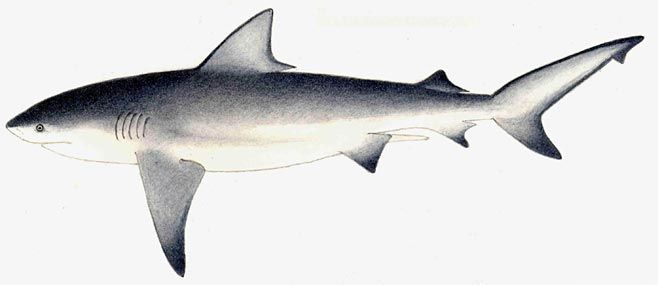|
Carcharhinus leucas (Zambezi shark)
(Valenciennes, in Müller & Henle, 1839)
Life
> Eukaryotes >
Opisthokonta
> Metazoa (animals) >
Bilateria >
Deuterostomia > Chordata >
Craniata > Vertebrata (vertebrates) > Gnathostomata (jawed
vertebrates) >.Chondrichthyes >
Elasmobranchii > Galeomorphii >
Carcharhiniformes >
Carcharhinidae
 |
|
Carcharhinus leucas (Zambezi shark) [Illustration
by Ann Hecht ©] |
Identification
A large, massive, thick-headed greyish shark
with a short, broad, blunt snout, small eyes, triangular saw-edged
upper teeth, broad triangular 1st dorsal fin less than 3.2 times 2nd
dorsal height, no interdorsal ridge, and no conspicuous markings on
fins. Underside white, fin tips dusky.
Size
To 3.2 m.
Range
East
coast from Cape St. Francis to Mozambique; circumtropical.
Habitat
Inshore to 152 m depth, tropical bays, beaches and estuaries, also
rivers and lakes, and in hypersaline waters of the St. Lucia
estuary.
Biology
Bears 1 to 13 young. A powerful, omnivorous
predator which feeds on a wide variety of bony fish, including
mullets, grunters, sea bream, soles, kob, sardines, snappers,
Spanish mackerel, rockcod, elf, flatheads, and sea catfish, as well
as other sharks and rays, mantis shrimp, crabs, squid, sea snails,
mammalian carrion, sea turtles, and occasionally garbage.
Human Impact
Potentially dangerous, several attacks on bathers attributed
to it in Natal. Steals fish from divers in Natal, prized by big-game
anglers and regularly taken by the anti-shark nets.
Text by Leonard J.V. Compagno, David A. Ebert
and Malcolm J. Smale
|
